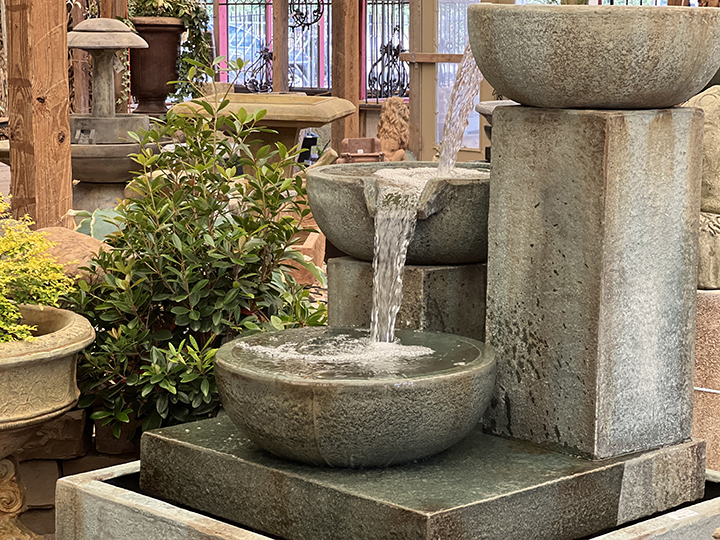Outdoor Fountain Care

Every wonder what’s in our Water Gallery? It’s our fountain display area, and it’s where our concrete statuary is located as well! One of the first things our guests ask is, ‘how do I take care of a fountain?’ Although they are pretty simple to take care of, there are a few tips that will help it remain in tip-top shape for years to come. Whether you choose a free standing fountain or a pond-less fountain, start by having the right electrical set up, a level location, and a way to get water to it. Also, for all fountains, try to keep tree limbs and shrubs trimmed back enough that they do not interfere with the operation of the feature.
Free Standing Fountains
This is the traditional fountain you likely think of when you consider fountains in general. Free standing fountains are self contained, which means you simply add water as needed. There is a basin to hold water and a submerged water pump, then tubing that moves water from the pump to another location from which the water then flows.
These types of fountains have a stopper or drain plug that can be removed for cleaning. Always unplug the fountain from the power source or turn the power off before draining the pump. If a submersible water pump runs when dry, the pump will burn up and no longer work. We recommend cleaning at least three times a year with a mild soap and a soft brush or cloth, making sure to remove debris like leaves and or dirt that has blown in over time. If your fountain is concrete, we recommend using Henri Concrete Sealer after cleaning and drying the concrete to protect the concrete and the color of the finish.
Summer Care
Algae is most prevalent is full sun situations, when water is warm. Algae can discolor water and if left unchecked long term, it can damage the finish. We recommend Sodium Percarbonate which is a dry granular form of Hydrogen Peroxide that when added to water creates a non-chlorine, pet and people friendly bleach, that kills the algae when applied regularly. Use Sodium Percarbonate in fountains with no aquatic life; not for use in natural water features. Mix approximately one teaspoon per ten gallons of water.
Winter Care
Before temperatures fall below freezing, it is recommended that you drain your fountain completely and cover so that water can not enter. Water expands as it freezes and thaws, which can crack or damage the fountain.
Pondless Water Feature Care
These water features typically have a firm water basin/ reservoir beneath the fountainhead, which could be a boulder, container or plumbed statue of some sort. In this basin, there are either strong AquaBlox or slotted grates that hold up the feature. Decorative stones usually cover the supporting grid, resulting in a disappearing water effect.
You can also use Sodium Percarbonate to control algae to keep the water running clear. The amount varies based on size but the ratio of one teaspoon per ten gallons of water is a good rule of thumb.
Unlike above ground, free standing fountains, when installed below ground, these pondless features are usually protected from freezing. During very cold freezing weather, ice could form. Any ice that forms reduces the volume of water moving through the feature. If the feature doesn’t have enough water to continually circulate at a good rate (ideally the entire volume of water should move twice an hour), the pump could burn up. An additional potential issue, if the water level falls, is that the ice could completely freeze over. If ice freezes solid and no water is moving in a pottery water feature, the ceramic pot could crack or sustain damage.
Feel free to contact us with questions!